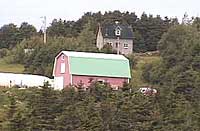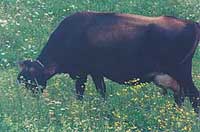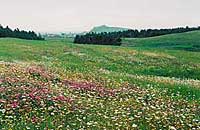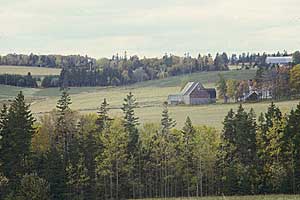Landscape Ecology and Agriculture
Conserving biodiversity in agricultural areas by building a green network
 |
 |
 |
 |
Agricultural landscapes in the Magdalen Islands, Quebec Sources: Daisy Kidston, David Patriquin | |
Prepared by Daisy Kidston
(2001)
TABLE OF CONTENTS (You may prefer Frames Version)
INTRODUCTION
| Currently, the greatest single threat to biodiversity is habitat destruction associated with agriculture. Fragmentation of wild habitat, the spread of crop-related pests and weeds into natural areas, soil erosion and pollution are all threats to biodiversity. They are threats for they change the landscape in ways which may be destructive to other creatures. |
| So what can be done? Is there any way for agriculture and biodiversity to co-exist without losing one or the other? |
| The answer to this question lies in the field of landscape ecology, the study of how the landscape's design affects ecological processes, and in the related concept of developing a green network to conserve biodiversity in agricultural landscapes. (*THE EUROPEAN CONSERVATION INSTITUTES RESEARCH NETWORK) |
| This website outlines the basic concepts and principles of landscape ecology and the green network and how these concepts can help us to conserve native biodiversity in agricultural areas. The Useful Links and Useful Literature sections identify sources of more information. |
LANDSCAPE ECOLOGY--What is it?
- Landscape
- Landscape Ecology
- Island Biogeography
(1) The Landscape--more than meets the eye!
| Perhaps when you hear the term landscape, images of a pedicured garden or landscape painting come to mind. Or perhaps you are reminded of the vista which you scan from your back deck or kitchen window. | A landscape is much more than a visual entity however. It is a complex structure in which plants, animals, the elements, ecosystem processes, humans and human infrastructure all interact to create a whole. The landscape is thus a holistic entity (Antrop 2000). |
| A useful metaphor when thinking of a landscape is an artist's mosaic (Foreman 1995). To make this mosaic, the artist uses watercolors, charcoal, bits of stone, seashells, reeds of grass, copper wire and so on. When these different ingredients are combined together, they create the single, unified masterpiece: the mosaic. |  Farms can be a beautiful part of the landscape mosaic. Farms can be a beautiful part of the landscape mosaic. Photo source: David Patriquin Foreman (1995) uses the term landscape mosaic to refer to the idea of a holistic landscape created from the interaction of different landscape components. Streams, forest stands, crop fields, roads, ponds and meadows are some examples of these landscape components. David Patriquin (Dalhousie University) |
(2) Landscape Ecology
| Landscape ecology is the study of how a landscape mosaic affects plant and animal populations (Foreman 1995, Hansson et. al 1995). It interweaves concepts of geography and ecology. Landscape ecology examines how the geographical concepts of space and time affect the ecological processes such as the movement and distribution of species' populations. Flows of energy, wind, heat and materials are also examined (Foreman 1995, Sanderson & Harris 2000). | |
| In 1939, a German by the name of Carl Troll used the term landscape ecology for the first time. He hoped the term would express the holistic union of ecology and geography (Naveh & Lieberman 1984). The concept was embraced by European landscape planners, foresters, farmers, and gardeners who furthered the growth of this science. | Landscape ecology eventually spread to North America, where ideas and events--particularly in the United States--brought new theories to the field. The International Biome Project, developments in the field of island biogeography in the 1970s, and crises in conservation within American national parks in the 1980s all contributed to the development of landscape ecology. In particular, these three events demonstrated that fragmentation and isolation of natural habitats can cause species extinction (Sanderson & Harris 2000). |
(3) Island Biogeography
 Edward.O. Wilson's knowledge of ant populations upon small islands helped
him to develop the Theory of Island Biogeography with Robert H. MacArthur (Quammen 1996). Edward.O. Wilson's knowledge of ant populations upon small islands helped
him to develop the Theory of Island Biogeography with Robert H. MacArthur (Quammen 1996).Photo Source: Scott Bauer, ARS Image Gallery . | ||
| Landscape ecology draws important concepts from the theory of island biogeography, a theory which came together through the work of two pioneering biologists: Edward O. Wilson and H. MacArthur (Morrison et. al 1992, Quammen 1996): | Through their studies of population biology on small islands, Wilson and MacArthur discovered that a natural equilibrium exists between the extinction and immigration of species. | That is, when a species goes extinct upon an island, a new species will immigrate to take its place. A balance between extinction and immigration--or what could be called a "dynamic stability"--therefore exists (Quammen 1996). |
| However, the new species which immigrates to the island will not necessarily be the same as the species which goes extinct. So though the number of species remains at equilibrium, the type of species can change. This is termed by Wilson and MacArthur as species turnover (Quammen 1996). | ||
| There is still more to Wilson and MacArthur's theory: they elucidated two geographical characteristics of small islands which affect immigration and extinction and hence the number of species They are: | 1) As the area or size of an island decreases , local extinction of the island's species increases . In general, as an island gets smaller, it can support fewer and fewer species. | 2) As the distance of an island from the mainland or other sources of new species (such as a large island ) increases ,the rate of local extinction of the island's species increases ; that's because there is less immigration of new species. |
| The SIZE of the island and DISTANCE of the island from other land forms thus can affect species equilibrium. | ||
| Yet what does island biogeography have to do with agriculture and biodiversity upon continents? In one word: fragmentation. Human practices such as agriculture can fragment areas of intact, natural habitat into separate, smaller patches. The landscape surrounding these patches (known as the matrix ) can isolate species in patches if the matrix does not provide hospitable habitat. The landscape matrix can hence act as an ocean surrounding a small island. | Therefore, a species can be "shipwrecked" on their patch, unable to reach other habitat areas and members of their species. If such isolation persists, chances are high that this local population shall become extinct(Morrison et al. 1992). | Appropriate landscape planning in agricultural areas can help reduce such extinctions and losses of biodiversity. This can be done through the creation of a green network |
Summary
Before looking at the GREEN NETWORK , here is a summary of whatwe have learned so far about the landscape,landscape mosaic and island biogeography.
If one undestands these basic concepts about landscape ecology, the concept of a green network will seem quite logical!
| 1) The landscape mosaic, like an ecosystem, is a holistic entity in which numerous different components interrelate to create a whole. A useful metaphor for a landscape is the artist's mosaic. | 2) Landscape ecology studies how the spatial and temporal features of the landscape mosaic affects the lives of the mosaic's occupants, namely the flora and fauna. | 3) Landscape ecologists are particularly interested in how the landscape affect the movement and distribution of species populations. |
| When studing how spatial and temporal features of the landscape mosaic affects species movement and distribution, it is vital to understand the concept of FRAGMENTATIONand EQUILIBRIUM . A natural equilibrium between immigration and extinction of species can exist for isolated habitat areas such as small islands and habitat patches. The size and distance from other land forms of the island/habitat patch can affect this equilibrium. | ||

A farm field in Kansas. Source: USDA
Photo by: Anson Eaglin
|
THE GREEN NETWORK |
The Building Blocks
| To build a green network, one uses the three basic building blocks of a landscape mosaic. They are: | ||
| Patch : an area of homogenous habitat which is different from its surroundings. Example: a patch of
forest surrounded by crop land. See More about Patches |
Corridor: a linear landscape feature--such as a road, hedgerow or stream--which connects at least two habitat patches. See More about Corridors |
Matrix:the area within which the patches and corridors are embedded. For example: cropland or pastureland. See More about the Matrix |
Key Concepts
| A green network is created when patches, corridors and the matrix are interconnected in such as way that species can survive within fragmented habitat. Though human practices such as agriculture may have reduced natural habitat to small, isolated patches, if the species can access these patches (by travelling through corridors or the matrix) then the species can survive. Though some general guidelines for green networks will be presented in this site, each species have unique habitat needs. Green networks are thus species specific--no single green network prototype exists for all creatures (Nature is too complex for such an easy solution!) | |
| Network Populations (metapopulations)
Species populations which live in green networks often form what is termed a NETWORK POPULATION (also known as a metapopulation). A network population is when a species population is separated into subpopulations which live in separate habitat patches spread across the landscape (Bunce & Jongman 1993). Such separation may be the result of habitat disturbances such as habitat fragmentation, or needs of the species which require members to disperse across the landscape. For example, a population may be too small for proper breeding to occur, or too competitive for resources, leading to members emigrating elsewhere (Morrison et. al 1992, Foreman 1995). Network populations are therefore in a state of dynamic stability or equilibrium as extinction (or emmigration) and immigration occurs. | |
|
Though a network population may exist in a state of dynamic stability or equilibrium, a threshold population size must be maintained. This is the concept
of Minimum Viable Population or MVP . The MVP is the minimum size of a species population size which allows a 95% chance of survival for the next 100 years. Scientists determine the MVP through models
which test various landscape structures and their effects on the MVP(*THE EUROPEAN CONSERVATION INSTITUTES RESEARCH NETWORK).
In order for network populations to have a "healthy" equilibrium, the MVP must be maintained (Foreman 1995).
Another important aspect to remember in terms of network populations is that they must travel across the landscape to survive . It is important that the green network facilitate such movement and not isolate sub-populations in their patches. Such isolation would be like shipwrecking members of a species on a deserted island, their extinction imminent. | |
Blinking Lights Theory
| Within a green network, some patches maybe occupied for long stable periods of time, whereas other patches may be largely unoccupied or occupied for only brief periods. For example, a patch may experience temporary extinction, or species may use the patch only for short periods at a time, say for a resting area. Hence a green network can resemble a string of lights in which lights blink on an off as metapopulation numbers shift from patch to patch. This means that though a patch may be unoccupied at one period of time (light off) it may become occupied again in the future (light on). Unutilized patches should therefore be conserved, as they may soon become useful to a species once again. |
SOME GREEN NETWORK GUIDELINES FOR THE FARM |
| FARM PRACTICE | WHAT IT INVOLVES | HOW IT CONTRIBUTES TO GREEN NETWORK | SPECIES WHICH BENEFIT |
| (1) Building and maintenance of healthy soil. | Building of soil organic matter, creation of humus, cultivation techniques which prevent compaction, protection from erosion, mixed cropping systems to prevent nutrient depletion. | MATRIX Healthy soil=healthy matrix. |
Organisms that are beneficial to crops such as earthworms, beetles, spiders; soil microrganisms ( funghi, bacteria and algae); birds and other wildlife that feed on soil organisms. |
| (2) Maintenance of small, diverse fields | Small fields divided by natural structures such as hedgerows and field margins which can be full of trees, vegetation and wild flowers. | CORRIDORS. The hedgerows and field margins which surround the small fields can provide both a movement corridor and a habitat for species. | Birds and small rodents, beetles and bees. |
| (3) Riparian management around streams. | Ensuring the riparian vegetation along stream is maintained and protected from excessive access by livestock. Prevention of pesticide run-off and nutrient-overloading from entering stream. |
PATCHES, CORRIDORS Both stream and riparian vegetation acts as a corridor which connects small patches of habitat (such as patches of forest) along the stream's route. |
Benefits a variety of life forms such as birds, reptiles, mammals, fish, amphibians. |
| (4) Extensive (non-intensive) grazing. | Under non-intensive grazing, many areas are left ungrazed. | MATRIX. Pastureland which can also act as habitat for wildlife. | Ground-nesting species such as rabbits, songbirds, grouse. |
| (5) Delay haying/use of flushing bars. | The delay of haying until mid-July in fields adjacent to wetlands and watercourses since animals such as birds and deer tend to be in the hay fields at these times. These animals will often not move when the tractor approaches, leading to their death or injury. If haying cannot be delayed, a flushing bar can be mounted onto tractors to scare creatures away. | MATRIX Cropland as habitat for wildlife. | Ducks, pheasants, partridges, sparrows, meadowlarks. White-tailed deer, rabbits. |
| (6) Planting of vegetation for wildlife. | Use native species whenever possible. Planting of shrubs like service berries and grapes can provide food for wildlife. "Grouped plantings" of evergreens provide shelter for birds and small mammals from rough weather and predators. | PATCHES Provides patches used for habitat, shelter, feeding areas. |
Birds, mammals. |
More guidelines! (Patch, Corridor, the Matrix)

This diversified farm lies within a forest matrix
Source: David Patriquin
GLOSSARY
Table of Contents
USEFUL LITERATURE AND CITED LITERATURE
USEFUL JOURNALS
USEFUL LINKS
|
